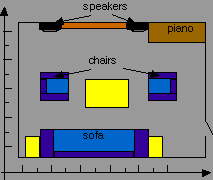
 |
Activity Based Physics Thinking Problems in Oscillations and Waves: |
1) A 15 cm violin string, fixed at both ends, is vibrating in its fundamental
mode (no nodes other than the endpoints). The speed of waves in this wire
is 250 m/s and the speed of sound in air is 350 m/s. What are (a) the frequency
and (b) the wavelength of the emitted sound wave? 2) You decide to build a pipe organ in your dormitory room using PVC
pipe. Estimate whether you could build an organ that would cover the entire
range of human hearing without bending any pipes. The coordinate grid on the edge of the picture has its large tick marks
separated by 1 meter. For ease of calculation, make the following assumptions:
a) Assume that the relevant objects lie on integer or half-integer grid
points of the coordinate system. (a) If I am sitting in my favorite chair (the one on the left), what
will be the lowest frequency I will lose to destructive interference? (If
you do not have a calculator, leave the result as an expression with numbers
that could be simply evaluated and estimate the result to one significant
figure.) These problems written and collected by E. F. Redish. These problems
may be freely used in classrooms. They may be copied and cited in published
work if the Activity Based Physics Thinking Problems in Physics site
is mentioned and the URL given. Web page created and edited by K. A. Vick. To contribute problems to this site, send them to redish@physics.umd.edu.
Maintained by
University of Maryland PERG
Activity Based Physics Thinking Problems in Oscillations and Waves: Sound
3) I have set up my two stereo speakers in my living room as shown
in the top view diagram in the figure at the right. I am worried that from
some positions in the room I will lose some important frequencies as a
result of interference.
b) Take the speed of sound to be 330 m/s.
c) Ignore the reflection of sound from the walls, floor, ceiling, and objects
in the room.
d) The speakers are in phase.
(b) What will happen if I am sitting in the middle of the sofa?
(c) Can I restore the frequency lost in part (a) by switching the leads
to one of the speakers, thereby reversing the phase of that source?
(d) With the leads reversed, what will happen to the sound for a person
sitting at the center of the sofa? 
Go back to the Activity Based Physics page
Go back to the Thinking Problems page
Go back to the Thinking Problems in Oscillations and Waves page
![]()
Comments and questions may be directed to
E. F. Redish
Last modified June 21, 2002